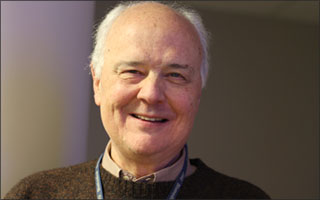Sound research: Eric Young dissects sound reception and hearing impairment

When Eric Young, PhD ’72, retires in July, he will leave behind a field far more complex than the one he found when he joined the BME faculty in 1975. Advances in technology as well as in our grasp of the workings of the central nervous system mean that we are poised for significant developments in understanding the brain, says Young, a professor of biomedical engineering, neuroscience and otolaryngology — head and neck surgery.
One goal of Young’s Neural Encoding Lab has been to understand how the brain processes information about sound and how it represents sound information through neural activity. Complex and nuanced mechanisms let us know what sounds we are hearing, where they are coming from and how to separate one sound from another, Young says. His lab uses engineering-based theories to figure out how neurons represent information about the world.
The lab’s second goal is to understand what happens to the brain when hearing loss occurs. Many researchers are interested in the result of damage to the ear’s hair cells and the auditory nerve fibers that connect them to the brain, Young says, but his research has focused on how that damage changes the representation of sound in the brain, and what can be done to address those changes. Neural activity follows “rules” based on the typical ear and brain, but when damage occurs, those rules may not work; results include tinnitus, for example, as well as the limitations of hearing aids to effectively overcome hearing loss. “Part of the solution to those problems will derive from understanding the effect of the hearing impairment on the central nervous system and how to deal with that,” Young says.
Young points to the development of the functional MRI and the genomic revolution as two advances with enormous impact on the field. The ability to put markers for functional activity in different cells allows researchers to understand how cells interact in ways impossible just 10 years ago, he says. The next step is to be able to study how the brain organizes itself on a macroscopic scale. “There is no more interesting problem in all of science than how the brain works. There is no harder problem,” Young says.
— Rachel Wallach
